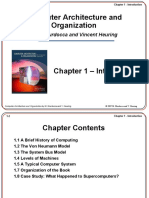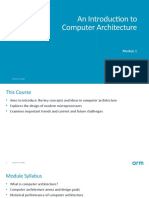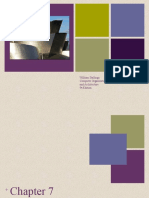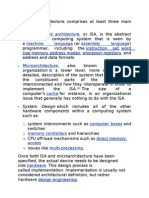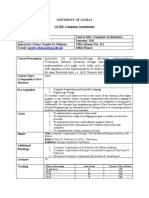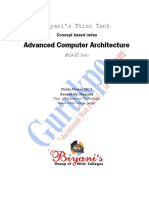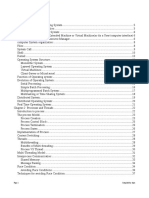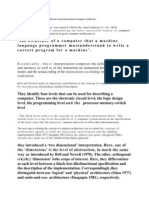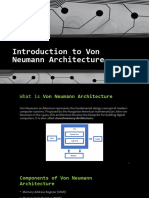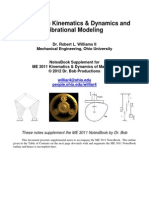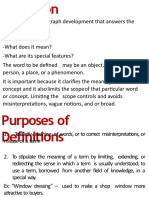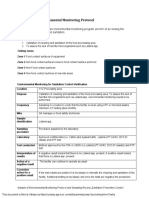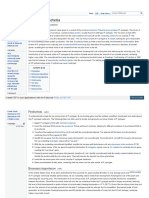1-1
Chapter 1 - Introduction
Computer Architecture and Organization
Miles Murdocca and Vincent Heuring
Chapter 1 Introduction
Computer Architecture and Organization by M. Murdocca and V. Heuring
2007 M. Murdocca and V. Heuring
�1-2
Chapter 1 - Introduction
Chapter Contents
1.1 A Brief History of Computing 1.2 The Von Neumann Model 1.3 The System Bus Model 1.4 Levels of Machines 1.5 A Typical Computer System 1.7 Organization of the Book 1.8 Case Study: What Happened to Supercomputers?
Computer Architecture and Organization by M. Murdocca and V. Heuring
2007 M. Murdocca and V. Heuring
�1-3
Chapter 1 - Introduction
Some Denitions
Computer architecture deals with the functional behavior of a computer system as viewed by a programmer (like the size of a data type 32 bits to an integer). Computer organization deals with structural relationships that are not visible to the programmer (like clock frequency or the size of the physical memory). There is a concept of levels in computer architecture. The basic idea is that there are many levels at which a computer can be considered, from the highest level, where the user is running programs, to the lowest level, consisting of transistors and wires.
Computer Architecture and Organization by M. Murdocca and V. Heuring
2007 M. Murdocca and V. Heuring
�1-4
Chapter 1 - Introduction
Wolf Radius Bone
Wolf radius bone ca. 25,00030,000 B.C. showing 55 cuts in groups of ve, suggesting a rudimentary form of multiplication or division.
(Source: Illustrated London News, October 2, 1937.)
Computer Architecture and Organization by M. Murdocca and V. Heuring
2007 M. Murdocca and V. Heuring
�1-5
Chapter 1 - Introduction
Tally Sticks
Original wooden tally sticks from Westminster, England, ca. 12501275 A.D.
( SSPL/The ImageWorks.)
Computer Architecture and Organization by M. Murdocca and V. Heuring
2007 M. Murdocca and V. Heuring
�1-6
Chapter 1 - Introduction
Chinese Abacus
Representation of 39,017 on a Chinese abacus.
Computer Architecture and Organization by M. Murdocca and V. Heuring
2007 M. Murdocca and V. Heuring
�1-7
Chapter 1 - Introduction
Cylinder Music Box
Victorian Swiss cylinder music box, dated 1862.
(Source: http://www.liveauctioneers.com/auctions/ebay/497199.html.)
Computer Architecture and Organization by M. Murdocca and V. Heuring
2007 M. Murdocca and V. Heuring
�1-8
Chapter 1 - Introduction
Pascals Calculating Machine
Performs basic arithmetic operations (early to mid 1600s). Does not have what may be considered the basic parts of a computer.
(Source: IBM Archives photograph.)
Computer Architecture and Organization by M. Murdocca and V. Heuring
2007 M. Murdocca and V. Heuring
�1-9
Chapter 1 - Introduction
Babbages Difference Engine #1
Working portion of Babbages Difference Engine No. 1, which is the rst known automatic calculator.
( SSPL/The ImageWorks.)
Computer Architecture and Organization by M. Murdocca and V. Heuring
2007 M. Murdocca and V. Heuring
�1-10
Chapter 1 - Introduction
The Jacquard Pattern Weaving Loom
The Jacquard pattern weaving loom (ca. 1804).
(Source: The Deutsches Museum.)
Computer Architecture and Organization by M. Murdocca and V. Heuring
2007 M. Murdocca and V. Heuring
�1-11
Chapter 1 - Introduction
Enigma
Siemens Halkse T-52 Sturgeon (Enigma) cipher machine.
(Photo and copy courtesy John Alexander, G7GCK Leicester, England.)
Computer Architecture and Organization by M. Murdocca and V. Heuring
2007 M. Murdocca and V. Heuring
�1-12
Chapter 1 - Introduction
Colossus
The Colossus (ca. 1944).
(Source: http://www.turing.org.uk/turing/scrapbook/electronic.html.)
Computer Architecture and Organization by M. Murdocca and V. Heuring
2007 M. Murdocca and V. Heuring
�1-13
Chapter 1 - Introduction
The ENIAC
(Time & Life Pictures/Getty Images.)
Computer Architecture and Organization by M. Murdocca and V. Heuring
2007 M. Murdocca and V. Heuring
�1-14
Chapter 1 - Introduction
Moores Law
Computing power doubles every 18 months, for the same price.
Computer Architecture and Organization by M. Murdocca and V. Heuring
2007 M. Murdocca and V. Heuring
�1-15
Chapter 1 - Introduction
UltraSPARC IV+ Layout
Die photo of UltraSPARC IV+, 295 million transistors, 19.7 mm 17.0 mm.
(Source: Best Servers of 2004, Kevin Krewell, 1/18/05, Microprocessor, www.MPRonline.com, Reed Electronics Group, ref: h10018.www1.hp.com/.)
Computer Architecture and Organization by M. Murdocca and V. Heuring
2007 M. Murdocca and V. Heuring
�1-16
Chapter 1 - Introduction
The von Neumann Model
The von Neumann model consists of ve major components: (1) input unit; (2) output unit; (3) arithmetic logic unit; (4) memory unit; (5) control unit.
Computer Architecture and Organization by M. Murdocca and V. Heuring
2007 M. Murdocca and V. Heuring
�1-17
Chapter 1 - Introduction
The System Bus Model
A renement of the von Neumann model, the system bus model has a CPU (ALU and control), memory, and an input/output unit. Communication among components is handled by a shared pathway called the system bus, which is made up of the data bus, the address bus, and the control bus. There is also a power bus, and some architectures may also have a separate I/O bus.
Computer Architecture and Organization by M. Murdocca and V. Heuring
2007 M. Murdocca and V. Heuring
�1-18
Chapter 1 - Introduction
Levels of Machines
There are a number of levels in a computer, from the user level down to the transistor level. Progressing from the top level downward, the levels become less abstract as more of the internal structure of the computer becomes visible.
Computer Architecture and Organization by M. Murdocca and V. Heuring
2007 M. Murdocca and V. Heuring
�1-19
Chapter 1 - Introduction
A Typical Computer System
(Computer case source http://www.baber.com/cases/mpe_md14_silver.htm. Motherboard source ftp://ftp.tyan.com/img_mobo/i_s2895.tif)
Computer Architecture and Organization by M. Murdocca and V. Heuring
2007 M. Murdocca and V. Heuring
�1-20
Chapter 1 - Introduction
The Motherboard
An AMD Opteron 200 based motherboard.
Source: Courtesy Tyan Computer Corp. (USA).
Computer Architecture and Organization by M. Murdocca and V. Heuring
2007 M. Murdocca and V. Heuring
�1-21
Chapter 1 - Introduction
End-to-End Network
End-to-end communication over a network. Highlighted architectural components include computers, hubs, switches, routers, rewalls, multiplexers, and phone switches.
Source: MSG Scott Bramwell.
Computer Architecture and Organization by M. Murdocca and V. Heuring
2007 M. Murdocca and V. Heuring
�1-22
Chapter 1 - Introduction
Manchester University Mark 1 / Baby
The Manchester University Mark 1, showing the Manchester Baby portion which was made operational on 21 June 1948.
(Source: The University of Manchester, www.computer50.org/mark1/ipmm1.mark1.html)
Computer Architecture and Organization by M. Murdocca and V. Heuring
2007 M. Murdocca and V. Heuring
�1-23
Chapter 1 - Introduction
Moores Law Restated
Computing power doubles every 18 months for the same price. Project planning needs to take this observation seriously: an architectural innovation that is being developed for a projected benet that quadruples performance in three years may no longer be relevant: the architectures that exist by then may already offer quadrupled performance and may look entirely different from what the innovation needs to be effective.
Computer Architecture and Organization by M. Murdocca and V. Heuring
2007 M. Murdocca and V. Heuring

